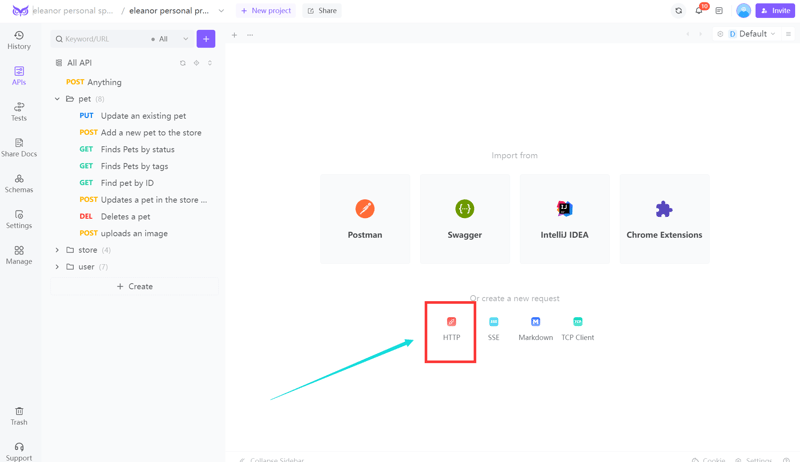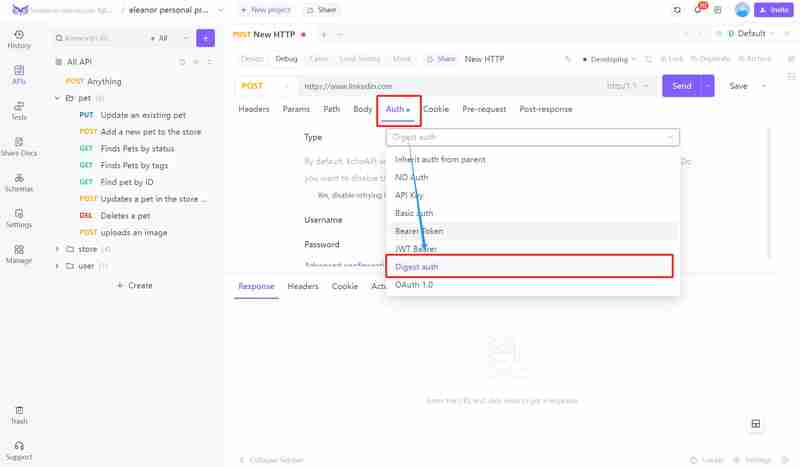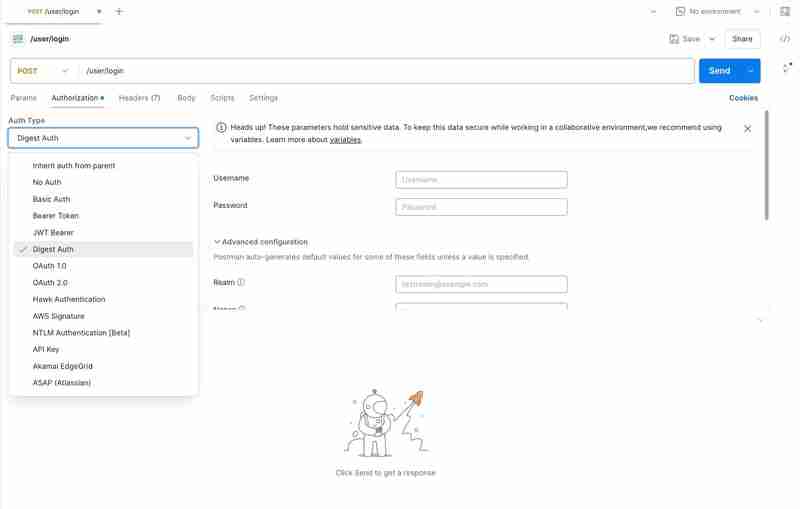如何在 REST API 中实现和调试摘要式身份验证
在保护 REST API 时,开发人员经常在各种身份验证机制之间进行选择。一种流行的选择是摘要式身份验证。本文探讨了使用摘要式身份验证的原因,解释了它是什么,提供了 Java 和 Go 中的实现示例,并提供了使用工具测试它的指导。
为什么对 REST API 使用摘要式身份验证?
摘要式身份验证是一种验证用户的安全方法,主要具有以下优点:
1.安全密码传输:
与以明文形式发送密码的基本身份验证不同,摘要式身份验证会对密码进行哈希处理,从而最大限度地降低被拦截的风险。
2.重放攻击预防:
通过合并对单个会话有效的随机数(随机生成的数字),摘要式身份验证可以降低重放攻击的风险。
3.完整性保护:
通过哈希响应来维护通信完整性,这有助于确保数据在传输过程中不被篡改。
这些功能使摘要式身份验证成为使用 REST API 时的一个不错的选择,特别是在安全性是首要考虑因素的环境中。
什么是摘要式身份验证?

摘要式身份验证是一种使用质询-响应机制的 HTTP 身份验证方案。其工作原理如下:
1.客户请求:
客户端向服务器发送没有凭据的请求。
2.服务器挑战:
服务器响应 401 Unauthorized 状态,包括 WWW-Authenticate 标头,其中包含随机数和其他信息。
3.客户响应:
客户端使用用户名、密码、随机数和其他因素生成哈希,并将其在授权标头中发送回。
4.服务器验证:
服务器将收到的哈希值与自己的计算结果进行比较。如果匹配,则用户通过身份验证。
此过程可确保敏感信息不会通过网络公开传输。
如何实施摘要式身份验证
Java实现
Java 使用“HttpURLConnection”类提供对摘要式身份验证的支持。这是一个例子:
import java.io.BufferedReader;
import java.io.InputStreamReader;
import java.net.HttpURLConnection;
import java.net.URL;
import java.util.Base64;
public class DigestAuthExample {
public static void main(String[] args) throws Exception {
String url = "https://example.com/api/resource";
String user = "username";
String password = "password";
// Initiate the request to get the nonce
HttpURLConnection connection = (HttpURLConnection) new URL(url).openConnection();
connection.setRequestMethod("GET");
int responseCode = connection.getResponseCode();
if (responseCode == 401) {
String authHeader = connection.getHeaderField("WWW-Authenticate");
// Extract the nonce and other parameters from authHeader
// Assuming nonce and realm are extracted
String nonce = "extracted_nonce";
String realm = "extracted_realm";
String ha1 = calculateHA1(user, realm, password);
String ha2 = calculateHA2("GET", "/api/resource");
String response = calculateResponse(ha1, nonce, ha2);
// Set the authorization header
connection.setRequestProperty("Authorization", "Digest username=\"" + user + "\", realm=\"" + realm + "\", nonce=\"" + nonce + "\", uri=\"/api/resource\", response=\"" + response + "\"");
// Re-attempt the request
connection = (HttpURLConnection) new URL(url).openConnection();
responseCode = connection.getResponseCode();
}
// Read the response
BufferedReader in = new BufferedReader(new InputStreamReader(connection.getInputStream()));
String inputLine;
StringBuilder response = new StringBuilder();
while ((inputLine = in.readLine()) != null) {
response.append(inputLine);
}
in.close();
System.out.println("Response: " + response.toString());
}
// Implement HA1, HA2, and calculateResponse functions
}
实施
在 Go 中,您可以利用带有自定义传输的“http”包来管理摘要式身份验证:
package main
import (
"fmt"
"net/http"
"time"
)
func main() {
client := &http.Client{}
req, err := http.NewRequest("GET", "https://example.com/api/resource", nil)
if err != nil {
panic(err)
}
req.SetBasicAuth("username", "password") // Placeholder for Digest Auth, requires proper implementation
resp, err := client.Do(req)
if err != nil {
panic(err)
}
defer resp.Body.Close()
fmt.Printf("Response status: %s\n", resp.Status)
}
注意:在此 Go 示例中,您通常需要手动处理摘要身份验证细节或使用支持它的库。
如何使用工具测试摘要式身份验证
可以使用各种工具来实现测试摘要式身份验证:
回声API:
要使用 EchoAPI 测试摘要式身份验证,请首先打开 EchoAPI 工具。创建新请求并设置方法(例如 GET)。接下来,输入 API 端点的 URL。

在“身份验证”设置中,选择“摘要式身份验证”,输入您的用户名和密码,然后发送请求。 EchoAPI 将自动管理随机数和标头生成。

邮差:
您可以设置新请求并使用“授权”选项卡选择“摘要式身份验证”并输入您的凭据。 Postman 将处理随机数并为您生成正确的标头。

卷曲:
使用“--digest”选项和用户凭据:
import java.io.BufferedReader;
import java.io.InputStreamReader;
import java.net.HttpURLConnection;
import java.net.URL;
import java.util.Base64;
public class DigestAuthExample {
public static void main(String[] args) throws Exception {
String url = "https://example.com/api/resource";
String user = "username";
String password = "password";
// Initiate the request to get the nonce
HttpURLConnection connection = (HttpURLConnection) new URL(url).openConnection();
connection.setRequestMethod("GET");
int responseCode = connection.getResponseCode();
if (responseCode == 401) {
String authHeader = connection.getHeaderField("WWW-Authenticate");
// Extract the nonce and other parameters from authHeader
// Assuming nonce and realm are extracted
String nonce = "extracted_nonce";
String realm = "extracted_realm";
String ha1 = calculateHA1(user, realm, password);
String ha2 = calculateHA2("GET", "/api/resource");
String response = calculateResponse(ha1, nonce, ha2);
// Set the authorization header
connection.setRequestProperty("Authorization", "Digest username=\"" + user + "\", realm=\"" + realm + "\", nonce=\"" + nonce + "\", uri=\"/api/resource\", response=\"" + response + "\"");
// Re-attempt the request
connection = (HttpURLConnection) new URL(url).openConnection();
responseCode = connection.getResponseCode();
}
// Read the response
BufferedReader in = new BufferedReader(new InputStreamReader(connection.getInputStream()));
String inputLine;
StringBuilder response = new StringBuilder();
while ((inputLine = in.readLine()) != null) {
response.append(inputLine);
}
in.close();
System.out.println("Response: " + response.toString());
}
// Implement HA1, HA2, and calculateResponse functions
}
失眠:
与 Postman 类似,您可以创建请求,选择摘要式身份验证,然后输入您的凭据。
通过利用这些工具,您可以以最少的配置有效地测试使用摘要式身份验证保护的 API。
结论
摘要式身份验证是一种针对 REST API 的强大身份验证机制,可提供比基本身份验证更高的安全性。通过确保密码经过哈希处理并减轻重放攻击,它为 API 交互提供了更安全的环境。通过正确的方法,在 Java 和 Go 中实现摘要式身份验证可以很简单,而 Postman、cURL 和 Insomnia 等工具则可以简化测试过程。由于安全性仍然是 API 开发的一个关键焦点,对于寻求保护其应用程序的开发人员来说,摘要式身份验证是一个可靠的选择。
以上是如何在 REST API 中实现和调试摘要式身份验证的详细内容。更多信息请关注PHP中文网其他相关文章!

热AI工具

Undresser.AI Undress
人工智能驱动的应用程序,用于创建逼真的裸体照片

AI Clothes Remover
用于从照片中去除衣服的在线人工智能工具。

Undress AI Tool
免费脱衣服图片

Clothoff.io
AI脱衣机

Video Face Swap
使用我们完全免费的人工智能换脸工具轻松在任何视频中换脸!

热门文章

热工具

记事本++7.3.1
好用且免费的代码编辑器

SublimeText3汉化版
中文版,非常好用

禅工作室 13.0.1
功能强大的PHP集成开发环境

Dreamweaver CS6
视觉化网页开发工具

SublimeText3 Mac版
神级代码编辑软件(SublimeText3)
 公司安全软件导致应用无法运行?如何排查和解决?
Apr 19, 2025 pm 04:51 PM
公司安全软件导致应用无法运行?如何排查和解决?
Apr 19, 2025 pm 04:51 PM
公司安全软件导致部分应用无法正常运行的排查与解决方法许多公司为了保障内部网络安全,会部署安全软件。...
 如何将姓名转换为数字以实现排序并保持群组中的一致性?
Apr 19, 2025 pm 11:30 PM
如何将姓名转换为数字以实现排序并保持群组中的一致性?
Apr 19, 2025 pm 11:30 PM
将姓名转换为数字以实现排序的解决方案在许多应用场景中,用户可能需要在群组中进行排序,尤其是在一个用...
 如何使用MapStruct简化系统对接中的字段映射问题?
Apr 19, 2025 pm 06:21 PM
如何使用MapStruct简化系统对接中的字段映射问题?
Apr 19, 2025 pm 06:21 PM
系统对接中的字段映射处理在进行系统对接时,常常会遇到一个棘手的问题:如何将A系统的接口字段有效地映�...
 IntelliJ IDEA是如何在不输出日志的情况下识别Spring Boot项目的端口号的?
Apr 19, 2025 pm 11:45 PM
IntelliJ IDEA是如何在不输出日志的情况下识别Spring Boot项目的端口号的?
Apr 19, 2025 pm 11:45 PM
在使用IntelliJIDEAUltimate版本启动Spring...
 如何优雅地获取实体类变量名构建数据库查询条件?
Apr 19, 2025 pm 11:42 PM
如何优雅地获取实体类变量名构建数据库查询条件?
Apr 19, 2025 pm 11:42 PM
在使用MyBatis-Plus或其他ORM框架进行数据库操作时,经常需要根据实体类的属性名构造查询条件。如果每次都手动...
 Java对象如何安全地转换为数组?
Apr 19, 2025 pm 11:33 PM
Java对象如何安全地转换为数组?
Apr 19, 2025 pm 11:33 PM
Java对象与数组的转换:深入探讨强制类型转换的风险与正确方法很多Java初学者会遇到将一个对象转换成数组的�...
 电商平台SKU和SPU数据库设计:如何兼顾用户自定义属性和无属性商品?
Apr 19, 2025 pm 11:27 PM
电商平台SKU和SPU数据库设计:如何兼顾用户自定义属性和无属性商品?
Apr 19, 2025 pm 11:27 PM
电商平台SKU和SPU表设计详解本文将探讨电商平台中SKU和SPU的数据库设计问题,特别是如何处理用户自定义销售属...
 如何利用Redis缓存方案高效实现产品排行榜列表的需求?
Apr 19, 2025 pm 11:36 PM
如何利用Redis缓存方案高效实现产品排行榜列表的需求?
Apr 19, 2025 pm 11:36 PM
Redis缓存方案如何实现产品排行榜列表的需求?在开发过程中,我们常常需要处理排行榜的需求,例如展示一个�...






